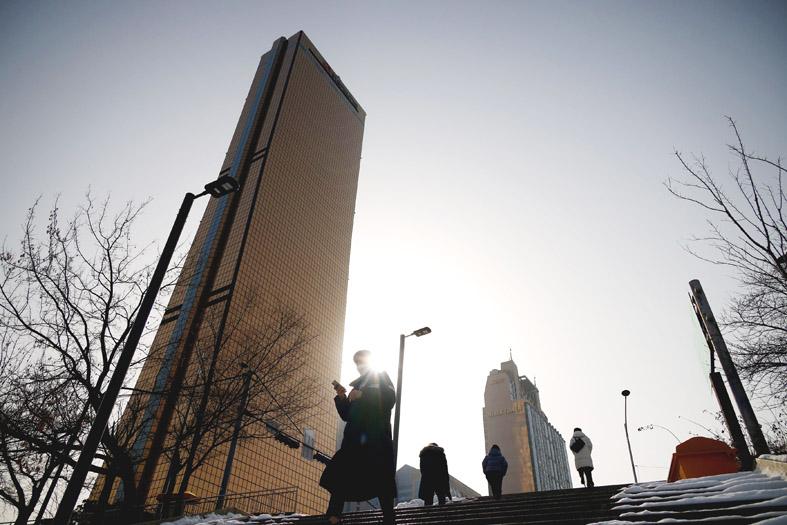South Korea has lost the most jobs in two decades and the unemployment rate hit a 10-year high as the businesses slashed hiring amid the COVID-19 pandemic.
The nation shed 628,000 jobs last month compared with the prior year, the 10th straight monthly drop and the most since February 1999.
Restaurants and hotels were the hardest hit, but manufacturing also lost more than 100,000 jobs for a second month, signaling that a recovery in tech exports has yet to translate into increased employment.

Photo: Reuters
The unemployment rate jumped to 4.6 percent, the highest since January 2010.
Economists had forecast a reading unchanged from November last year’s 4.1 percent.
The worst job losses since the late 1990s Asian financial crisis could spur more calls for the Bank of Korea to put increased emphasis on employment in setting monetary policy.
The bank is expected to hold rates at a record low when it meets tomorrow.
The deteriorating labor market also adds pressure on the government and lawmakers to come up with more ways to shore up the economy.
South Korean Minister of Finance Hong Nam-ki said in a statement that difficulties in the labor market are likely to persist through next month and pledged to do more to combat them.
South Korean President Moon Jae-in’s administration plans to give 4.6 trillion won (US$4.2 billion) in cash handouts to millions of South Koreans before next month’s Lunar New Year holiday and front load fiscal spending in the first half of the year.
The damage to the jobs market reflects the tightening of social distancing rules after the country’s daily infection tally last month surged above 1,000.
Curtailed hours for most shops, and the shutdown of karaoke parlors and other businesses have hurt workers in the service sector, especially during the holiday season.
Restaurant and hotels shed 313,000 jobs, roughly double the losses of November last year.
Employment in the manufacturing industry was down by 110,000 workers in the month, a slightly smaller decline than in the previous month, but still worrisome given the economy’s dependence on exports and factory work.
“Manufacturing has been under pressure from greater labor costs even before COVID-19 and the virus only adds to the trouble,” said Sung Tae-yoon, a professor of economics at Yonsei University in Seoul. “An exports recovery isn’t necessarily going to translate into more jobs in the tech sector, which has already automated much of its manufacturing.”
Construction continued to see improving employment, adding 23,000 workers, amid a government push to increase public housing.

Taiwan Semiconductor Manufacturing Co (TSMC, 台積電) last week recorded an increase in the number of shareholders to the highest in almost eight months, despite its share price falling 3.38 percent from the previous week, Taiwan Stock Exchange data released on Saturday showed. As of Friday, TSMC had 1.88 million shareholders, the most since the week of April 25 and an increase of 31,870 from the previous week, the data showed. The number of shareholders jumped despite a drop of NT$50 (US$1.59), or 3.38 percent, in TSMC’s share price from a week earlier to NT$1,430, as investors took profits from their earlier gains

In a high-security Shenzhen laboratory, Chinese scientists have built what Washington has spent years trying to prevent: a prototype of a machine capable of producing the cutting-edge semiconductor chips that power artificial intelligence (AI), smartphones and weapons central to Western military dominance, Reuters has learned. Completed early this year and undergoing testing, the prototype fills nearly an entire factory floor. It was built by a team of former engineers from Dutch semiconductor giant ASML who reverse-engineered the company’s extreme ultraviolet lithography (EUV) machines, according to two people with knowledge of the project. EUV machines sit at the heart of a technological Cold

Taiwan’s long-term economic competitiveness will hinge not only on national champions like Taiwan Semiconductor Manufacturing Co. (TSMC, 台積電) but also on the widespread adoption of artificial intelligence (AI) and other emerging technologies, a US-based scholar has said. At a lecture in Taipei on Tuesday, Jeffrey Ding, assistant professor of political science at the George Washington University and author of "Technology and the Rise of Great Powers," argued that historical experience shows that general-purpose technologies (GPTs) — such as electricity, computers and now AI — shape long-term economic advantages through their diffusion across the broader economy. "What really matters is not who pioneers

TAIWAN VALUE CHAIN: Foxtron is to fully own Luxgen following the transaction and it plans to launch a new electric model, the Foxtron Bria, in Taiwan next year Yulon Motor Co (裕隆汽車) yesterday said that its board of directors approved the disposal of its electric vehicle (EV) unit, Luxgen Motor Co (納智捷汽車), to Foxtron Vehicle Technologies Co (鴻華先進) for NT$787.6 million (US$24.98 million). Foxtron, a half-half joint venture between Yulon affiliate Hua-Chuang Automobile Information Technical Center Co (華創車電) and Hon Hai Precision Industry Co (鴻海精密), expects to wrap up the deal in the first quarter of next year. Foxtron would fully own Luxgen following the transaction, including five car distributing companies, outlets and all employees. The deal is subject to the approval of the Fair Trade Commission, Foxtron said. “Foxtron will be